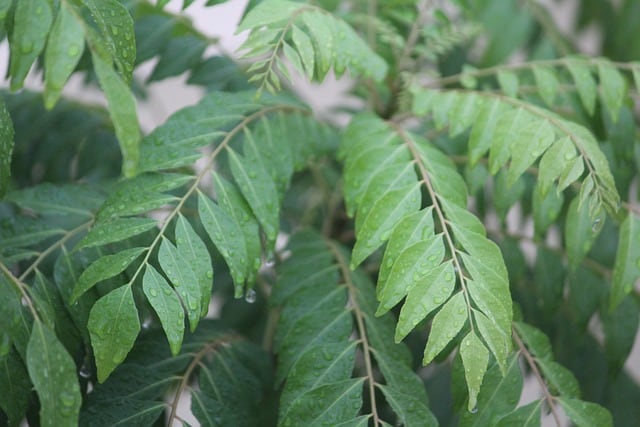Turmeric is a valuable addition to your spice rack due to its vibrant color and mild, earthy flavor. Beyond its culinary use, it offers numerous health benefits. Curry leaves, on the other hand, bring a unique and aromatic touch to your dishes, enhancing their flavor profile and making them more authentic, especially in South Indian cuisine.
Turmeric and curry leaves are both essential ingredients in Indian cuisine, but they serve different purposes and have distinct flavors.
Here’s a comparison to get started:
Turmeric
- Flavor: Turmeric has a warm, earthy, and slightly bitter flavor with a mild peppery note. It’s not particularly aromatic.
- Color: It imparts a bright yellow color to dishes and is often used as a natural food coloring.
- Form: Turmeric is most commonly used in its ground form, but you can also find it fresh as a rhizome.
- Culinary Uses: Turmeric is used as a spice and seasoning in a wide range of dishes. It’s a key ingredient in curry powder and lends its distinctive color to Indian curries and rice dishes. It’s also used in pickles and as a natural dye.
- Health Benefits: Turmeric is renowned for its anti-inflammatory and antioxidant properties and is used in traditional medicine.
Curry Leaves
- Flavor: Curry leaves have a unique, aromatic flavor that’s citrusy, slightly nutty, and reminiscent of curry. They have a strong aroma.
- Color: They don’t add color to dishes but are used for their flavor.
- Form: Curry leaves are typically used fresh from the curry tree, and they are added whole or chopped to dishes.
- Culinary Uses: Curry leaves are a staple in South Indian cuisine. They are often used to season oil at the beginning of a dish, lending their aromatic flavor to the oil and, subsequently, the entire dish. They are a key ingredient in many South Indian curries, stews, and rice dishes.
- Health Benefits: While curry leaves are not as well-known for specific health benefits as turmeric, they are a source of vitamins and antioxidants and are believed to have some health-promoting properties.
In summary, turmeric is primarily used for its color and mild flavor, while curry leaves are used for their aromatic and distinctive taste. Both are valuable additions to Indian cooking, but they serve different roles in seasoning and flavoring dishes.
Turmeric And Curry Leaves Head To Head
Here’s a table comparing the characteristics of turmeric and curry leaves, followed by a list of food dishes that use each ingredient:
| Characteristic | Turmeric | Curry Leaves |
|---|---|---|
| Texture | Typically ground into a fine powder. | Fresh leaves, often used whole or chopped. |
| Flavor Release | Mild and earthy, released when cooked. | Strong and citrusy, released when sautéed in oil. |
| Color | Imparts a bright yellow/orange hue. | No significant color contribution. |
| Common Uses | Spice in curries, rice, soups, and more. Natural food coloring. | Aromatic seasoning in South Indian dishes. |
| Baking | Used in some baked goods, like golden milk. | Typically not used in baking. |
| Storage | Store in a cool, dark place to maintain freshness. | Best used fresh; can be frozen for longer storage. |
| Cost | Generally affordable. | Moderately priced, depending on availability. |
| Smell | Mild aroma. | Strong and distinctive citrusy scent. |
| Taste | Warm, slightly bitter with a mild peppery note. | Citrusy, nutty, and reminiscent of curry. |
| Culinary Advantages | Adds color and subtle flavor. Known for health benefits. | Imparts a unique, aromatic taste to dishes. |
Food Dishes That Use Turmeric
- Curry: Turmeric is a key ingredient in various curry dishes, such as chicken curry, vegetable curry, and lentil curry.
- Rice Dishes: It’s often added to rice for color and flavor, like in biryani or turmeric-infused rice.
- Golden Milk: A warm beverage made with turmeric, milk, and spices, believed to have health benefits.
- Pickles: Turmeric is used in pickling vegetables to add color and flavor.
- Soups: It’s commonly found in lentil soups and broths.
Food Dishes That Use Curry Leaves
- Tempered Dishes: In South Indian cuisine, curry leaves are often used to season oil at the start of a dish, like in tadka for dal.
- Curries: They’re an essential ingredient in South Indian curries, such as curry leaf chicken or curry leaf fish curry.
- Rice Dishes: Curry leaves can be added to lemon rice or coconut rice for a burst of flavor.
- Chutneys: They’re used in making chutneys, like coconut chutney or curry leaf chutney.
- Stews: Curry leaves are used in various vegetable and meat stews for their aromatic touch.
Both turmeric and curry leaves play crucial roles in Indian cooking, but they serve different purposes. Turmeric adds color and mild flavor, while curry leaves contribute a distinctive citrusy aroma and taste to dishes.
Final Thoughts
Here are the main differences between turmeric and curry leaves:
- Turmeric is a bright yellow-orange rhizome (underground stem) of the Curcuma longa plant. Curry leaves come from the Murraya koenigii tree.
- Turmeric is used primarily as a spice and coloring agent. Curry leaves are used as an herb that adds flavor.
- Turmeric has a mild, slightly bitter earthy flavor. Curry leaves have a very distinct, strong citrus-like aroma and flavor.
- Turmeric is often used ground in curries, mustard, etc. Curry leaves are typically used whole and removed before serving.
- Turmeric contains curcumin which gives it coloring properties and health benefits. Curry leaves do not share these attributes.
- Cuisine usage differs – Turmeric is widely used across India. Curry leaves are more prominent in South Indian cooking.
- Form sold – Turmeric powder; Curry leaves are sold fresh or dried whole.
So in summary, turmeric is a spice/coloring agent while curry leaves are an aromatic herb. Both are integral to Indian cuisine but used in different ways.

